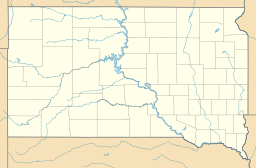Grass Lake (Minnehaha County, South Dakota) facts for kids
Quick facts for kids Grass Lake |
|
|---|---|
| Location | Minnehaha County, South Dakota |
| Coordinates | 43°35′22″N 97°02′21″W / 43.5894972°N 97.0391571°W |
| Type | lake |
| Surface elevation | 1,572 feet (479 m) |
Grass Lake is a natural lake located in the state of South Dakota, in the United States. It's a cool place to learn about nature and how lakes get their names!
Contents
What is Grass Lake?
Grass Lake is a natural body of water. This means it was formed by nature, not by people building a dam. It's a freshwater lake, which is important for many plants and animals.
Where is Grass Lake located?
You can find Grass Lake in Minnehaha County, South Dakota. Minnehaha County is in the eastern part of South Dakota. The lake's exact spot is marked by these coordinates: 43°35′22″N 97°02′21″W / 43.5894972°N 97.0391571°W. It's a quiet spot, away from big cities.
Why is it called Grass Lake?
The lake got its name because of the many marsh grass plants that grow in and around it. Marsh grass is a type of plant that loves wet places. It often grows tall and thick near the edges of lakes and wetlands. This grass is very important for the lake's ecosystem.
The Importance of Marsh Grass
Marsh grass helps the lake in many ways:
- Habitat: It provides a safe home for small fish, insects, and baby birds.
- Food: Some animals eat the grass or the tiny creatures living on it.
- Water Quality: The roots of the grass help to filter the water, keeping it cleaner. They also hold the soil in place, which stops dirt from washing into the lake.
- Shelter: Tall grasses offer protection from predators for many animals.
What kind of life can you find at Grass Lake?
Even though Grass Lake is small, it's likely home to many different living things. Lakes like this often have:
- Fish: Small fish might swim among the grasses.
- Birds: Waterfowl like ducks and geese might visit. They use the marsh grass for nesting and finding food.
- Insects: Dragonflies, mosquitoes, and other insects live near the water. They are food for birds and fish.
- Other Plants: Besides marsh grass, you might see water lilies or other aquatic plants.
Grass Lake is a great example of a natural habitat. It shows how different parts of nature, like water and plants, work together to create a home for wildlife.



